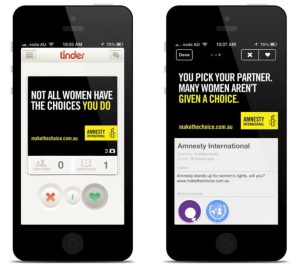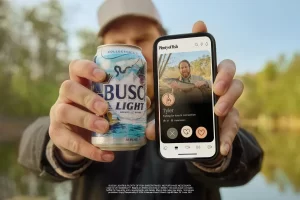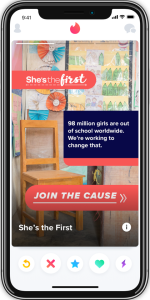In 2024, dating apps have become more than just a way to find love—they’re now a bustling marketplace where millions of users connect daily. With over 57 million people in the U.S. using dating apps and platforms like Tinder boasting 75 million users alone, the potential for brands to engage with these audiences is massive. But here’s the catch: the success of your advertising efforts depends on understanding the unique behaviors, demographics, and preferences of these users.
Did you know that 75% of American dating app users check their apps at work, and nearly 80% log in at least once a day? Or that the key demographic for Plenty of Fish is 35-49-year-olds, who make up 40% of its users? These stats aren’t just numbers—they’re the key to crafting ads that resonate and convert. Whether you’re targeting Gen Z on Tinder or professionals on Hinge, this guide will walk you through how to make your native ads click with diverse audiences across dating platforms.
What is Native Advertising?
Native advertising is a form of paid media where the ad experience follows the natural form and function of the user experience in which it is placed. It’s a non-disruptive method of advertising that blends in with its surroundings. An example of native advertising is when a sponsored article appears in a news website’s feed, seamlessly blending in with the other news articles but clearly labeled as “sponsored” or “promoted.” This allows advertisers to reach audiences in a way that feels organic and native to the platform, rather than standing out as a traditional ad.
While some would argue that programmatic display ads or banner ads are more effective, native advertising has gained popularity in recent years due to its ability to engage and resonate with users. This is especially true for the tech-savvy and active audience of dating app users who are quick to spot traditional advertisements and often have ad blockers installed.
Native advertising also allows for a higher level of personalization and targeting, as the content can be tailored to fit seamlessly with the platform’s tone and audience interests. This creates a more immersive experience for the user, increasing their chances of engaging with the content and taking action.
Now that we’ve got the basic definition out of the way, let’s get into the meat and potatoes of how to apply your native ads on popular dating apps.
Demographics of Popular Dating Apps
Tinder
Tinder is one of the most popular dating apps, with a user base that skews younger, typically ranging from 18 to 35 years old. According to Statista, Tinder is the most popular dating app with over 50 million monthly active users worldwide! The app is known for its casual, swipe-driven interface, attracting users looking for casual encounters and short-term relationships. Psychographically, Tinder users are often more interested in quick, visual-based interactions, making eye-catching and concise ads more effective. Behavioral patterns on Tinder show that users prioritize visual appeal and instant gratification, so ads should be designed to capture attention within seconds.
Key Takeaways:
- Target Audience: Primarily 18-35 years old, seeking casual interactions.
- Ad Style: Visually appealing, concise, and engaging.
- Strategy: Focus on immediate impact and quick user interaction.
Hinge
Hinge is marketed as the app ‘designed to be deleted,’ emphasizing meaningful relationships over casual encounters. The user base tends to be slightly older, often in their mid-20s to 40s, and is more relationship-oriented. Hinge’s unique features, such as in-depth profiles and prompts, encourage users to engage in thoughtful conversations. Native ads on Hinge should align with this focus on deeper connections, promoting products or services that enhance relationship-building or cater to long-term commitment.
Key Takeaways:
- Target Audience: Mid-20s to 40s, focused on meaningful relationships.
- Ad Style: Thoughtful, relationship-focused, and aligned with user intent.
- Strategy: Emphasize narratives and products that support long-term connections.
BLK
BLK is a dating app that caters specifically to Black singles, celebrating cultural identity and fostering connections within the Black community. The audience is diverse in age but unified by cultural relevance and shared experiences. User engagement on BLK often revolves around cultural pride and community, making it essential for native ads to be culturally sensitive and resonant. Ads should reflect and respect the cultural values of the audience, potentially incorporating elements of Black culture and community-focused messaging to build trust and engagement.
Key Takeaways:
- Target Audience: Black singles, diverse in age but unified by cultural identity.
- Ad Style: Culturally sensitive and community-focused.
- Strategy: Incorporate cultural elements and resonate with community values.
Plenty of Fish (POF) attracts a broad demographic, including users in their late 20s to 50s, many of whom are looking for a variety of relationship types, from casual dating to long-term partnerships. The platform’s user behavior is characterized by detailed profiles and a search-based interface, allowing for more targeted advertising. Native ads on POF should be versatile, appealing to both casual and serious daters, and should leverage the platform’s detailed profile data to deliver personalized, relevant content.
Key Takeaways:
- Target Audience: Broad, ranging from late 20s to 50s, with varied relationship goals.
- Ad Style: Versatile and personalized, catering to diverse user intentions.
- Strategy: Use detailed profile data to create targeted, relevant ads.
Crafting The Right Message with Effective Ad Types
Crafting effective native ads on dating apps hinges on seamlessly integrating content with the app’s user experience. To achieve this, ads must blend naturally into the app’s design, mirroring its tone and style to ensure a cohesive user journey. Whether it’s the sleek simplicity of Tinder or the relationship-centric focus of Hinge, native ads should feel like an organic part of the app environment. They should enhance user engagement rather than disrupt it. This alignment with the app’s atmosphere not only makes the ads more appealing but also increases their chances of resonating with users.
Visual and interactive elements are key to capturing attention in the fast-paced environment of dating apps. Our agency recommends using eye-catching images, GIFs, and videos to make ads stand out. Interactive features like swipeable content or polls can drive deeper engagement. For instance, an ad that mimics Tinder’s iconic swipe function can create a seamless experience, making the interaction feel like a natural extension of the app itself. This not only draws users in but also encourages them to interact with the ad in a way that feels familiar and enjoyable.
Developing narratives that resonate with users’ dating experiences helps advertisers create ads that feel relevant and impactful. Whether promoting relationship-building or catering to casual encounters, the ad copy should tap into the emotions and desires of the audience. For example, an ad on Hinge might emphasize the potential for meaningful connections, while one on POF could highlight spontaneous, fun interactions. Tailoring the message to the context of each app ensures that the ad speaks directly to users, fostering a stronger connection and driving meaningful engagement.
Easy Checklist for Authentic Ad Copy:
- Align with App Design:
- Ensure your ads mirror the app’s tone and style.
- Blend ads seamlessly into the user interface to avoid disruption.
- Use Visual and Interactive Elements:
- Incorporate eye-catching images, GIFs, and videos to grab attention.
- Utilize interactive features like swipes, polls, or quizzes to enhance engagement.
- Focus on Storytelling:
- Develop narratives that resonate with users’ dating experiences.
- Tailor ad messaging to align with relationship goals (e.g., casual vs. meaningful).
- Customize for Each App:
- Adapt your ad strategy to match the unique atmosphere and user intent of each platform (e.g., casual on Tinder, relationship-focused on Hinge).
- Encourage User Interaction:
- Design ads that feel like a natural extension of the app, encouraging users to engage without breaking the flow of their experience.
- Test and Optimize:
- Continuously A/B test and optimize ads based on user feedback and engagement metrics to improve effectiveness.
Targeting and Personalization Strategies
Targeting and personalization are critical components of successful native advertising campaigns on dating apps. By leveraging the data these platforms collect, advertisers can refine audience segments and ensure their ads reach the most relevant users. Dating apps like Tinder, Hinge, BLK, and POF provide insights into user behaviors, preferences, and interactions, enabling advertisers to tailor their messages to specific demographics or psychographics. For instance, understanding how users interact with profiles, their swiping patterns, and their preferences can help brands create more targeted ads that resonate with users’ intentions, whether they seek casual encounters or long-term relationships.

Personalization goes a step further by tailoring ads to match individual user profiles. Dynamic content enables advertisers to modify their messaging based on user location, interests, and activity within the app. For instance, a brand could provide location-specific promotions or showcase products matching a user’s expressed interests. This level of personalization enhances the relevance of the ad and improves the user experience by presenting custom and natural content. As dating apps continue to prioritize user engagement and satisfaction, personalized ads that seamlessly integrate into the user’s journey are more likely to be positively received.
Step By Step: Native Advertising on Dating Apps
Now that we’ve explored the methods for successfully engaging with your audience on dating apps, it’s time to dive into the practical steps for implementing native advertising. This guide will walk you through the process, ensuring your ads capture users’ attention and lead to conversions.
Step 1: Choose an Ad Platform and Create an Account
The first step to getting started with native advertising on dating apps is choosing the right platform to run your campaigns. Consider platforms that offer advertising placements on dating apps, such as Meta (formerly Facebook) Ads Manager, MatchMediaGroup, or Google Ads. These platforms provide a wide range of targeting options to ensure your ads reach the right audience. After selecting a platform, create an account and familiarize yourself with the campaign setup process. Each platform typically offers tutorials or guidance to help advertisers make the most of their features.
Step 2: Define Your Target Audience
Identifying your target audience is crucial for any native ad campaign. Define your audience based on demographics like age, gender, and location, along with user interests and behaviors specific to dating apps. If you’re advertising a product or service that appeals to certain lifestyles, use dating app data or platform insights to refine your audience further. By doing so, your ads resonate with users most likely to engage with your content and increase the chances of conversions. Platforms like Meta allow advertisers to leverage detailed targeting options, making it easier to reach the right users on apps such as Tinder, Hinge, and BLK.
Step 3: Select Your Ad Format
Once your target audience is set, choose the most effective ad format. You can select between image-based ads, which typically blend seamlessly with the dating app’s interface, or video-based ads, which tend to attract more attention and engagement. Some platforms may even offer interactive formats such as swipeable ads that mimic the dating app experience. Your choice should align with your campaign goals—whether it’s building awareness, driving engagement, or pushing conversions. For example, Tinder’s video-based ads often have a higher engagement rate because they fit into the platform’s visual-first layout.
Step 4: Develop Engaging Ad Content
Content is the heart of any ad campaign. Focus on creating mobile-optimized visuals and copy that seamlessly blend with the app’s user experience. Make sure the content is appealing without feeling disruptive. This might involve incorporating a dating-related theme or tone that aligns with the app’s environment. Use short, snappy text with a clear call-to-action (CTA)—whether it’s “Swipe Right for More,” “Find Out Now,” or something equally engaging. Pair the text with compelling imagery or videos that capture attention quickly.
Step 5: Set Your Budget and Targeting Parameters
After crafting the perfect ad, it’s time to allocate your budget and set targeting parameters. Depending on your platform, you can opt for cost-per-click (CPC) or cost-per-impression (CPM) strategies. These allow you to control spending based on how often users interact with or view your ads. Most ad platforms also allow you to choose targeting parameters like time of day, device type, and user behavior to maximize relevance. Carefully adjust these settings to ensure you’re reaching your desired audience efficiently.
Step 6: Launch and Monitor Your Campaign
Before launching, double-check your campaign settings and submit your ad for approval. Once your campaign goes live, it’s important to track its performance regularly. Most platforms offer real-time performance tracking with metrics like click-through rates (CTR), engagement, and conversions. Monitoring these insights will help you understand how well your ads are performing and whether any adjustments are necessary. You can also experiment with A/B testing different versions of your ad to see which one drives the best results.
Step 7: Analyze and Report Results
Finally, after your campaign has run its course, it’s essential to analyze the data. Look for insights into which ad formats, audiences, and messaging performed best. Create a comprehensive report summarizing the campaign’s performance, highlighting key metrics like engagement, ROI, and conversion rates. This data will help you optimize future campaigns and fine-tune your approach to native advertising on dating apps.
By following these steps, you’ll be well-equipped to launch effective native ad campaigns that resonate with dating app users and drive tangible results.
Success Stories
Tinder’s Partnership with Domino’s Pizza
Tinder’s partnership with Domino’s Pizza, known as the “Swipe Right to Pizza” campaign, was a brilliant example of using native advertising to engage users in a fun and interactive way. The campaign allowed Tinder users to swipe right on a special Domino’s profile, giving them a chance to win a free pizza. This strategy capitalized on the casual and spontaneous nature of dating app interactions while tapping into a universally loved product: pizza. By aligning with users’ love for food and the app’s core swipe feature, the campaign seamlessly integrated into the user experience, driving high engagement and creating a memorable brand interaction. This collaboration was successful because it connected with the audience’s lifestyle, blending convenience and enjoyment in a lighthearted, relatable way.
Hinge and Spotify
Hinge, a dating app that focuses on building meaningful connections, partnered with music streaming platform Spotify to create a successful native advertising campaign. The goal was to connect users through their shared music preferences by featuring each user’s top Spotify artists on their profile. This campaign received widespread praise for its creative approach and successfully promoted both Hinge and Spotify as platforms that value personal connections.
These success stories showcase the effectiveness of native advertising in engaging a highly interested audience. Integrating advertisements seamlessly into the user experience of dating apps, these campaigns have not only boosted brand awareness but also delivered value to users. With an increasing number of companies adopting native advertising on dating apps, it’s evident that this trend is becoming a mainstay. This suggests that we can anticipate many more success stories in the future as brands further explore the potential of this potent marketing tool.
Overall, native advertising on dating apps has proven to be a successful strategy for large corporations looking to reach a highly engaged audience. By establishing strategic partnerships with popular dating apps and seamlessly integrating their products or services into the user experience, these companies have effectively increased brand awareness and connected with potential customers in an impactful way. With the increasing popularity of dating apps, we can only expect to see more success stories in the years to come. So, it’s clear that native advertising on dating apps is a trend that is here to stay and will continue to benefit both corporations and users alike. So, we can definitely say that native advertising on dating apps for large corporations has been a winning strategy with proven results, making it a go-to marketing tool for many companies. Let these success stories inspire your brand to explore the potential of native advertising on dating apps and tap into this ever-growing market.
Plenty of Fish and Busch Light Partners

The Busch Light and Plenty of Fish partnership celebrates the love of fishing within the 21+ community.The introduction of the Fish Pic Badge, alongside the limited edition Fishing Cans, is intended to unite individuals who share a passion for fishing. This campaign encourages mutual interest in fishing but also provides an opportunity for Plenty of Fish members to compete for enticing prizes through native advertising. The collaboration reflects the commitment of Plenty of Fish to create a welcoming environment for outdoor enthusiasts to connect over their passions. Additionally, the sweepstakes provide an engaging opportunity for US residents aged 21 and over to participate in the campaign.As the summer season approaches, what better way to bring together individuals than through a shared love for fishing. Busch Light and Plenty of Fish have joined forces to celebrate this beloved pastime with their partnership. This collaboration not only aims to unite members of the 21+ community who enjoy fishing, but also offers exciting opportunities for them to win prizes through native advertising.
Additional Resources
When planning and executing native advertising campaigns on dating apps, the right tools can make all the difference. There are numerous platforms designed to help streamline and optimize your native ad efforts. Tools like Taboola and Outbrain are well-known for amplifying content through native ads, while platforms like AdRoll offer robust retargeting features. Additionally, StackAdapt and Nativo are highly recommended for managing programmatic native ad campaigns, offering granular targeting and reporting features that enhance performance. For dating app-specific campaigns, working with an agency like Propellant Media can ensure a more tailored strategy, integrating your ads seamlessly into the user experience.
To further your knowledge of native advertising on dating apps, there are several key resources worth exploring. Delve into case studies on successful campaigns, while books like “The Native Advertising Playbook” by Rebecca Lieb offer an in-depth exploration of strategies. Additionally, courses on platforms like Udemy and LinkedIn Learning provide structured learning on native advertising and how to maximize its effectiveness across digital platforms.
Utilizing the right tools and expanding your knowledge base will equip you to craft ads that resonate with dating app users, driving engagement and improving campaign performance.
Conclusion
 Native advertising on dating apps presents a unique opportunity for marketers to engage with a highly active and receptive audience. Understanding the demographics and behaviors of users on platforms like Tinder, BLK, and POF is like cracking a secret code! By creating authentic and engaging content, businesses can drive significant engagement and achieve their marketing goals. So, get started developing your campaigns today! Watch as your ads become a natural extension of the user experience, leading to higher conversions and meaningful results.
Native advertising on dating apps presents a unique opportunity for marketers to engage with a highly active and receptive audience. Understanding the demographics and behaviors of users on platforms like Tinder, BLK, and POF is like cracking a secret code! By creating authentic and engaging content, businesses can drive significant engagement and achieve their marketing goals. So, get started developing your campaigns today! Watch as your ads become a natural extension of the user experience, leading to higher conversions and meaningful results.
Looking to get started with native advertising soon? Propellant Media is here to help. Book your FREE 30-minute demo with our team today!


